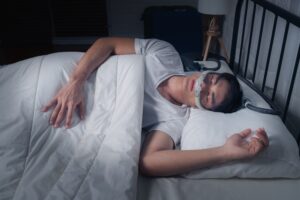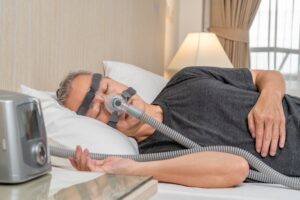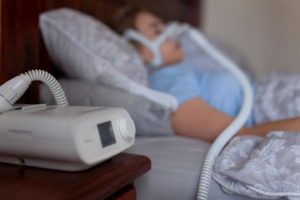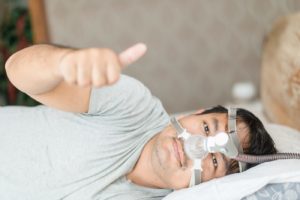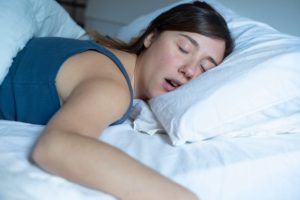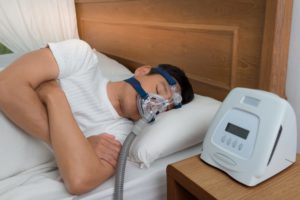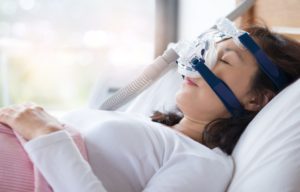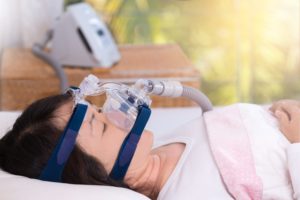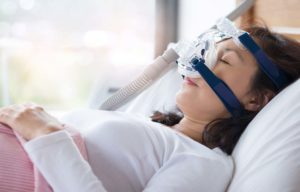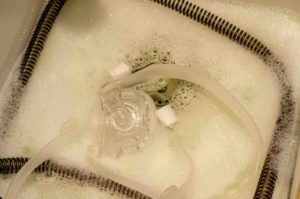When you buy through our links, we may earn a commission. Products or services may be offered by an affiliated entity. Learn more.
CPAP: Continuous Positive Airway Pressure
- CPAP machines deliver a continuous stream of air, preventing airway collapse from obstructive sleep apnea.
- The consistent airflow of CPAP therapy reduces disruptions in breathing and improves overall sleep quality.
- When a person first begins using CPAP they may experience discomfort, congestion, dry mouth, and irritation.
- A sleep specialist may recommend other PAP therapy devices depending on your unique situation and sleep apnea severity.
People who are diagnosed with a sleep-related breathing disorder are often prescribed a treatment called positive airway pressure (PAP) therapy . Although there are multiple ways of delivering PAP therapy, continuous positive airway pressure (CPAP) is a common sleep apnea treatment.
Consistent use of a CPAP machine provides both short- and long-term benefits to people diagnosed with sleep apnea. Learn about using a CPAP machine, choosing the right machine for you, and tips to help you get the most out of CPAP therapy.
Suspect You May Have Sleep Apnea?
Answer three questions to understand if you should be concerned.
What Is a CPAP Machine?
A CPAP machine is a bedside device that delivers positive airway pressure and is used to treat obstructive sleep apnea (OSA) and other breathing problems. People with OSA experience an abnormal number of shallow breaths or complete lapses in breathing while asleep. Abnormal nighttime breathing can result in snoring, daytime tiredness, nighttime awakenings, and a variety of other health complications .
CPAP therapy may also be prescribed to treat central sleep apnea (CSA) , another sleep-related breathing disorder. In people with CSA, breathing slows or stops due to a lapse in the signals from the brain that regulate breathing.
To help reduce periods of abnormal breathing in people with sleep apnea, a CPAP machine pushes air into a person’s airway, keeping it open as they sleep. As a result, sleepers treated with CPAP should experience fewer obstructive apneas and central apneas during sleep.
Read: At-Home Sleep Study
How Do CPAP Machines Work?
A CPAP machine operates by pushing air through a tube into a sleeper’s nose, mouth, or both as they sleep. This air applies pressure to the airway, reducing the likelihood the airway will collapse and obstruct breathing. With a traditional CPAP machine, air is pushed out continuously at one fixed rate of pressure.
CPAP machines are not the only machines that can provide positive airway pressure. Understanding the differences among the various machines that deliver PAP therapy may help shed light on why a certain type of machine is recommended by a doctor or sleep specialist.
CPAP vs APAP
CPAP machines may deliver air at a fixed rate, or may continually change the rate of airflow based on internal technology that senses changes in a person’s breathing during sleep. When a CPAP machine emits air at varying levels of pressure, it is called an auto-titrating CPAP (APAP or auto-CPAP).
Instead of emitting a fixed rate of air, an APAP machine senses when a person’s airway is likely narrowed or blocked, then increases pressure to open the airway. On average, an APAP delivers air at a lower rate than a CPAP machine that uses a fixed rate of airflow. As a result, people using an APAP may be better able to tolerate therapy.
BiPAP vs CPAP
Unlike a fixed-rate CPAP machine that delivers air at a constant pressure, a bilevel positive airway pressure (BiPAP) machine pushes out air at different rates, depending on whether a sleeper is breathing in or breathing out. Generally, the rate of airflow is higher as a person inhales and lower as a person exhales.
In addition to releasing air at two fixed rates of airflow, some BiPAP machines are capable of releasing air at an adaptable rate based on what the machine determines is necessary to reduce abnormal breathing. In these instances, the machine is called an auto-titrating BiPAP.
Generally, a CPAP machine is the first type of treatment prescribed to a person with obstructive sleep apnea (OSA). BiPAP may be recommended to people with OSA who do not respond well to a CPAP machine. BiPAP therapy may also be prescribed to people who have both OSA and another type of sleep-disordered breathing.
CPAP vs ASV
An adaptive servo-ventilation (ASV) machine is primarily used to treat people with central sleep apnea when a CPAP machine is not effective in reducing abnormal breathing . Like a BiPAP machine, an ASV releases air at different rates of pressure when a person breathes in and when they breathe out. Also, the machine delivers air at a pre-set rate of pressure when it detects the person has stopped breathing.
Like APAP and some BiPAP machines, ASV machines can also be auto-titrating. The auto-titrating ASV machines use technology to determine how much air a sleeper needs to keep their airway open as they breathe out. As a result, the auto-titrating ASV machines release air at varying pressure during exhales.
Components of CPAP Machines
Although CPAP machines can vary somewhat depending on the manufacturer, they generally contain these components :
- Mask: A mask sits over the sleeper’s nose or both their nose and mouth, creating a seal so air can be pushed into the airway without escaping.
- Mask straps: Straps help keep the mask in position, so it remains on a person’s face as they sleep.
- Tubing: A plastic tube or hose connects the mask to the CPAP machine’s motor that pushes out air. Air moves from the machine, through the tube, and into the mask and the airway.
- Motor: The CPAP machine motor blows air into the connected tube. Most machines must be plugged into an electrical outlet to power the motor, but some battery-operated CPAP machines are available. The motor component of the machine also often contains an air filter and, in some cases, a heated humidifier.
Types of CPAP Masks
CPAP masks designed for at-home use come in a variety of styles. A doctor can help choose the mask that offers the best fit .
- Nasal mask: A nasal mask pumps air through a mask that covers just the nose.
- Nasal pillow: A nasal pillow delivers air through two prongs that extend into the nose .
- Full face mask: Most full face masks cover the nose and the mouth, but some may cover the full face.
- Oral mask: An oral mask is an uncommon style that covers just the mouth.
While not typically used in a person’s home, other types of CPAP masks may be used in hospitalized patients. For example, a nasopharyngeal mask involves inserting tubes into the nose that extend into the throat.
Benefits of CPAP Machines
The primary benefit of using a CPAP machine is a reduction in episodes of abnormal breathing during sleep. As a result, CPAP therapy may improve symptoms associated with sleep-disordered breathing, resulting in:
- Improved sleep quality
- Reduced snoring
- Less daytime sleepiness
- Increased work productivity
- Improved mood
Consistently using a CPAP machine overtime can provide additional benefits. For example, CPAP use may:
- Lower high blood pressure
- Reduce risk of stroke
- Improve memory
- Improve cognitive ability
Related: Best CPAP Machines
Potential Side Effects
Although CPAP machines are very useful for treating sleep-disordered breathing, many people do not use their prescribed machine as much as recommended. Using a CPAP machine may produce side effects, such as:
- Congestion
- Runny nose
- Irritated eyes
- Dry mouth
- Sore throat
- Nosebleeds
- Redness or irritation on top of the nose
- Bloating or nausea
- Respiratory infection
When a person first begins using a CPAP machine, they might find the mask uncomfortable. They may also feel embarrassed or claustrophobic while wearing it. A person’s doctor or sleep specialist can help to minimize side effects by making adjustments or trying another mask type, or by offering suggestions to make using a CPAP machine more comfortable.
Tips for Comfortably Using a CPAP Machine
Fortunately, there are ways to make using a CPAP machine feel more comfortable if you experience discomfort or side effects at first.
- Ask about a humidifier: If your CPAP machine does not have a heated humidifier, switching to one that does may reduce the likelihood of dry mouth, nosebleeds, and congestion.
- Try another mask: There are multiple styles of CPAP masks. If one feels uncomfortable or allows air to escape, another type might be a better fit.
- Clean your CPAP machine: Be sure to clean your machine regularly, as directed by the manufacturer. A clean machine can reduce the chance of infection.
- Adjust machine settings: If you have trouble sleeping because the air coming out of the CPAP machine feels too forceful, see your sleep specialist. They may adjust the airflow rate or have the machine begin at a lower rate and ramp up over time.
- Consider an APAP machine: When the air of a fixed-rate CPAP feels uncomfortable, an APAP machine that automatically adjusts the rate of airflow to your needs might be a better fit.
- Wear earplugs: If the sound of your CPAP machine makes it difficult for you to fall or stay asleep, consider wearing earplugs to block out the sound.
How to Select the Right CPAP Machine for You
CPAP machines are classified as medical devices, so they are only available with a prescription . If you are diagnosed with sleep-disordered breathing and your doctor or sleep specialist wants you to try CPAP therapy, they will likely prescribe the best CPAP machine for you. Of course, you can ask questions and give feedback if you feel the machine they choose is not a good fit.
Frequently Asked Questions About CPAP Machines
CPAP machines range from about $500 to $1,000 or more. Optional features like a heated humidifier can add to the cost of a CPAP machine.
Health insurance may cover some or all of the cost of a CPAP machine. Check with your insurance provider or doctor to learn how much you would have to pay out-of-pocket for a CPAP machine. Follow-up visits with a doctor or sleep-specialist may be required for continued coverage of your CPAP machine.
If you are diagnosed with obstructive sleep apnea and both your doctor and CPAP supplier are enrolled in Medicare, then Medicare will cover some of the cost of your CPAP machine. Initially, they may only cover a three-month trial, then require additional doctor’s visits before continuing coverage. You may still have to pay out-of-pocket for 20% of the cost of a CPAP machine and accessory supplies, like the mask and tube.
The first step in getting a CPAP machine is to see a doctor to learn if CPAP therapy is right for you. After an initial evaluation, a doctor may refer you to a sleep specialist, who can order a sleep study if they suspect you have a form of sleep-disordered breathing. If the sleep study confirms that you could benefit from CPAP therapy, your sleep specialist or doctor will instruct you on how to select and purchase a CPAP machine.
A fixed-air CPAP releases air at a constant rate of pressure, regardless of whether or not you are breathing normally or experiencing a lapse in breathing. An APAP machine uses sensors and technology to determine when a person has slowed or stopped breathing. Then, the APAP adjusts its airflow accordingly.
Since an APAP machine can detect when a person has stopped or slowed their breathing, it can also provide an estimate of how many abnormal breathing events a person experiences per night and per hour. The machine can also detect when the mask is leaking air.

Still have questions? Ask our community!
Join our Sleep Care Community — a trusted hub of sleep health professionals, product specialists, and people just like you. Whether you need expert sleep advice for your insomnia or you’re searching for the perfect mattress, we’ve got you covered. Get personalized guidance from the experts who know sleep best.
References
14 Sources
-
Brown, L. K. & Lee, W. (2021, September 17). Titration of positive airway pressure therapy for adults with obstructive sleep apnea. In N. Collop (Ed.). UpToDate., Retrieved July 5, 2022, from
https://www.uptodate.com/contents/titration-of-positive-airway-pressure-therapy-for-adults-with-obstructive-sleep-apnea -
National Heart, Lung, and Blood Institute. (2022, March 24). CPAP., Retrieved July 5, 2022, from
https://www.nhlbi.nih.gov/health/cpap -
American Academy of Sleep Medicine. (2014). The International Classification of Sleep Disorders – Third Edition (ICSD-3). Darien, IL.
https://aasm.org/ -
National Heart, Lung, and Blood Institute. (2022, March 24). Sleep apnea: Symptoms., Retrieved July 6, 2022, from
https://www.nhlbi.nih.gov/health/sleep-apnea/symptoms -
Badr, M. S. (2021, September 29). Central sleep apnea: Treatment. In N. Collop (Ed.). UpToDate., Retrieved July 5, 2022, from
https://www.uptodate.com/contents/central-sleep-apnea-treatment -
A.D.A.M. Medical Encyclopedia. (2021, July 12). Central sleep apnea. MedlinePlus., Retrieved July 11, 2022, from
https://medlineplus.gov/ency/article/003997.htm -
Strohl, K. P. (2020, September). Obstructive sleep apnea. Merck Manual Professional Version., Retrieved July 5, 2022, from
https://www.merckmanuals.com/professional/pulmonary-disorders/sleep-apnea/obstructive-sleep-apnea -
Kuzniar, T. J., & Freedman, N. (2022, April 7). Mode selection for positive airway pressure titration in adult patients with central sleep apnea syndromes. In S. M. Harding (Ed.). UpToDate., Retrieved July 11, 2022, from
https://www.uptodate.com/contents/mode-selection-for-positive-airway-pressure-titration-in-adult-patients-with-central-sleep-apnea-syndromes -
Pinto, V. L., & Sharma, S. (2022, May 2). Continuous positive airway pressure. In StatPearls. StatPearls Publishing., Retrieved July 7, 2022, from
https://www.ncbi.nlm.nih.gov/books/NBK482178/ -
A.D.A.M. Medical Encyclopedia. (2020, January 29). Positive airway pressure treatment. MedlinePlus., Retrieved July 7, 2022, from
https://medlineplus.gov/ency/article/001916.htm -
Deshpande, S., Joosten, S., Turton, A., Edwards, B. A., Landry, S., Mansfield, D. R., & Hamilton, G. S. (2016). Oronasal masks require a higher pressure than nasal and nasal pillow masks for the treatment of obstructive sleep apnea. Journal of Clinical Sleep Medicine, 12(9), 1263–1268.
https://pubmed.ncbi.nlm.nih.gov/27448430/ -
Weaver, T. E. (2021, September 28). Assessing and managing nonadherence with continuous positive airway pressure (CPAP) for adults with obstructive sleep apnea. In N. Collop (Ed.). UpToDate., Retrieved July 7, 2022, from
https://www.uptodate.com/contents/assessing-and-managing-nonadherence-with-continuous-positive-airway-pressure-cpap-for-adults-with-obstructive-sleep-apnea -
American Academy of Sleep Medicine. (2018, October 19). FDA reclassifies positive airway pressure as a Class II medical device., Retrieved July 8, 2022, from
https://aasm.org/fda-reclassifies-positive-aiway-pressure-class-ii-medical-device/ -
U.S. Centers for Medicare and Medicaid Services. (n.d.). Continuous positive airway pressure (CPAP) devices, accessories, & therapy., Retrieved July 8, 2022, from
https://www.medicare.gov/coverage/continuous-positive-airway-pressure-devices






